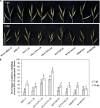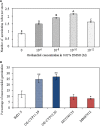Overexpression of a Cytochrome P450 Monooxygenase Involved in Orobanchol Biosynthesis Increases Susceptibility to Fusarium Head Blight
- PMID: 33868356
- PMCID: PMC8048717
- DOI: 10.3389/fpls.2021.662025
Overexpression of a Cytochrome P450 Monooxygenase Involved in Orobanchol Biosynthesis Increases Susceptibility to Fusarium Head Blight
Abstract
Fusarium Head Blight (FHB) is a cereal disease caused primarily by the ascomycete fungus Fusarium graminearum with public health issues due to the production of mycotoxins including deoxynivalenol (DON). Genetic resistance is an efficient protection means and numerous quantitative trait loci have been identified, some of them related to the production of resistance metabolites. In this study, we have functionally characterized the Brachypodium distachyon BdCYP711A29 gene encoding a cytochrome P450 monooxygenase (CYP). We showed that BdCYP711A29 belongs to an oligogenic family of five members. However, following infection by F. graminearum, BdCYP711A29 is the only copy strongly transcriptionally induced in a DON-dependent manner. The BdCYP711A29 protein is homologous to the Arabidopsis thaliana MAX1 and Oryza sativa MAX1-like CYPs representing key components of the strigolactone biosynthesis. We show that BdCYP711A29 is likely involved in orobanchol biosynthesis. Alteration of the BdCYP711A29 sequence or expression alone does not modify plant architecture, most likely because of functional redundancy with the other copies. B. distachyon lines overexpressing BdCYP711A29 exhibit an increased susceptibility to F. graminearum, although no significant changes in defense gene expression were detected. We demonstrate that both orobanchol and exudates of Bd711A29 overexpressing lines stimulate the germination of F. graminearum macroconidia. We therefore hypothesize that orobanchol is a susceptibility factor to FHB.
Keywords: Brachypodium distachyon; Fusarium Head Blight; cytochrome P450; orobanchol; susceptibility.
Copyright © 2021 Changenet, Macadré, Boutet-Mercey, Magne, Januario, Dalmais, Bendahmane, Mouille and Dufresne.
Conflict of interest statement
The authors declare that the research was conducted in the absence of any commercial or financial relationships that could be construed as a potential conflict of interest.
Figures









Similar articles
-
Reduced susceptibility to Fusarium head blight in Brachypodium distachyon through priming with the Fusarium mycotoxin deoxynivalenol.Mol Plant Pathol. 2015 Jun;16(5):472-83. doi: 10.1111/mpp.12203. Epub 2014 Oct 22. Mol Plant Pathol. 2015. PMID: 25202860 Free PMC article.
-
A Brachypodium UDP-Glycosyltransferase Confers Root Tolerance to Deoxynivalenol and Resistance to Fusarium Infection.Plant Physiol. 2016 Sep;172(1):559-74. doi: 10.1104/pp.16.00371. Epub 2016 Jul 4. Plant Physiol. 2016. PMID: 27378816 Free PMC article.
-
Host-Induced Silencing of Fusarium graminearum Genes Enhances the Resistance of Brachypodium distachyon to Fusarium Head Blight.Front Plant Sci. 2019 Oct 30;10:1362. doi: 10.3389/fpls.2019.01362. eCollection 2019. Front Plant Sci. 2019. PMID: 31737001 Free PMC article.
-
Transcriptomics of cereal-Fusarium graminearum interactions: what we have learned so far.Mol Plant Pathol. 2018 Mar;19(3):764-778. doi: 10.1111/mpp.12561. Epub 2017 Jun 7. Mol Plant Pathol. 2018. PMID: 28411402 Free PMC article. Review.
-
Fusarium Head Blight in Durum Wheat: Recent Status, Breeding Directions, and Future Research Prospects.Phytopathology. 2019 Oct;109(10):1664-1675. doi: 10.1094/PHYTO-03-19-0095-RVW. Epub 2019 Sep 3. Phytopathology. 2019. PMID: 31369363 Review.
Cited by
-
A Unique Sulfotransferase-Involving Strigolactone Biosynthetic Route in Sorghum.Front Plant Sci. 2021 Dec 14;12:793459. doi: 10.3389/fpls.2021.793459. eCollection 2021. Front Plant Sci. 2021. PMID: 34970291 Free PMC article.
-
UvCYP503 is required for stress response and pathogenicity in Ustilaginoidea virens.Virulence. 2025 Dec;16(1):2472877. doi: 10.1080/21505594.2025.2472877. Epub 2025 Mar 9. Virulence. 2025. PMID: 40033930 Free PMC article.
-
BS-Seq reveals major role of differential CHH methylation during leaf rust resistance in wheat (Triticum aestivum L.).Mol Genet Genomics. 2022 May;297(3):731-749. doi: 10.1007/s00438-022-01879-1. Epub 2022 Mar 19. Mol Genet Genomics. 2022. PMID: 35305147
-
Exploring and applying genes to enhance the resistance to Fusarium head blight in wheat.Front Plant Sci. 2022 Oct 27;13:1026611. doi: 10.3389/fpls.2022.1026611. eCollection 2022. Front Plant Sci. 2022. PMID: 36388594 Free PMC article. Review.
-
Callose and Salicylic Acid Are Key Determinants of Strigolactone-Mediated Disease Resistance in Arabidopsis.Plants (Basel). 2024 Oct 2;13(19):2766. doi: 10.3390/plants13192766. Plants (Basel). 2024. PMID: 39409636 Free PMC article.
References
LinkOut - more resources
Full Text Sources
Other Literature Sources

